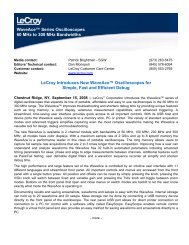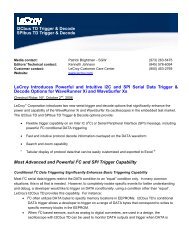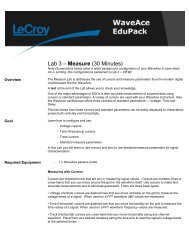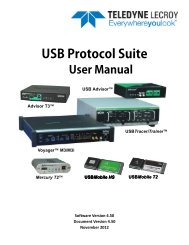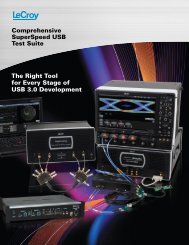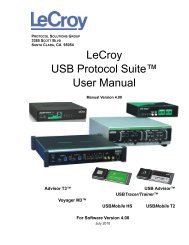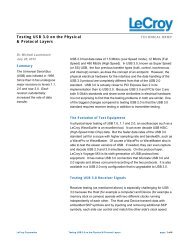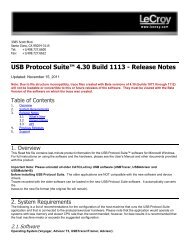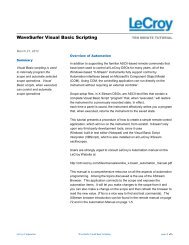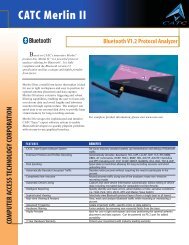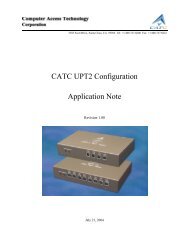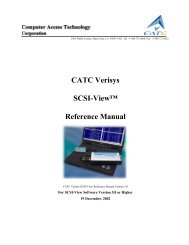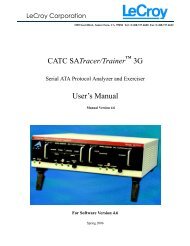Performance Verification Test Record - LeCroy
Performance Verification Test Record - LeCroy
Performance Verification Test Record - LeCroy
You also want an ePaper? Increase the reach of your titles
YUMPU automatically turns print PDFs into web optimized ePapers that Google loves.
WaveLink Series Differential Probe (13-25 GHz)<br />
The interconnect tips are designed to keep response within a narrow range so they are<br />
interchangeable, and interconnect leads manufactured at the same time have nearly identical<br />
performance. Likewise, if a damping resistor on the solder-in lead is replaced using the<br />
Replacing Damping Resistors on the Solder-In Interconnect Lead (on page 47) topic,<br />
performance is still guaranteed. If an interconnect lead tip is damaged beyond field repair and<br />
requires factory replacement, <strong>LeCroy</strong> recommends you return the probe platform/cable<br />
assembly and amplifier module to the factory for a complete calibration and test to ensure<br />
guaranteed performance. This is because there may be small differences in performance of<br />
interconnect leads supplied at different times.<br />
If a positioner tip (PT) is purchased at time of original shipment of the other probe components,<br />
this is also calibrated and serialized with the other components. If it is purchased at a later date<br />
and you have provided <strong>LeCroy</strong> with the original probe serial number the tip is used with, <strong>LeCroy</strong><br />
calibrates the positioner tip to your existing components and supplies a file on a USB memory<br />
stick for installation on your oscilloscope. Follow the instructions provided with the file and<br />
memory stick in order to load this file and ensure proper calibrated performance with your<br />
existing probe components. Finally, if the carbon composite resistive pogo-pins need to be<br />
changed on your PT tip, see Correctly Replacing Carbon Composite Resistive Pogo-Pin Tips in<br />
Dxx05-PT (on page 50) for more information.<br />
De-Embedding Probes<br />
<strong>LeCroy</strong> probes are calibrated at the factory using a Vector Network Analyzer (VNA) to measure a<br />
system (probe plus test fixture) frequency response. The test fixture is de-embedded from the<br />
measurement using <strong>LeCroy</strong>'s Eye Doctor tools so the remaining frequency response is due to the<br />
combination of the test signal and the probe loading on the test circuit. The system frequency<br />
response is then calculated for these remaining circuit elements.<br />
Since the WaveLink probe impedance is high, the effect of probe loading is greatly reduced and<br />
the impact on circuit measurement is much lower than when using a probe with lower<br />
impedance. However, if you wish to de-embed the effect of probe loading on your circuit, you<br />
can use the appropriate equivalent circuit model in the Probe Input Impedance and Loading (on<br />
page 82) topic and <strong>LeCroy</strong>'s Eye Doctor tools to accomplish this.<br />
WL-HBW-OM-E RevC 20



